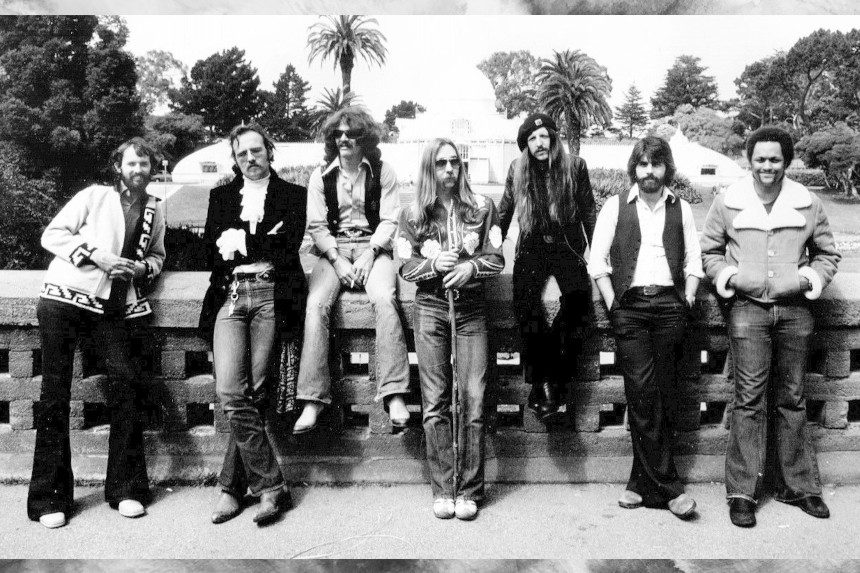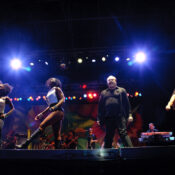Formed in San Jose, California in 1970, The Doobie Brothers released their self-titled debut album 50 years ago this week. With a foundational rock sound that easily worked in elements of other genres like soul and R&B, The Doobie Brothers proved themselves by maintaining success while alternating between two iconic and recognizable vocalists. Inducted into the Vocal Group Hall of Fame 16 years before they made it to the Rock and Roll Hall, the band continues to be celebrated for its harmonies, its hits, and its range. Here’s how it all came together.
It all started with John Hartman. Moby Grape co-founder Skip Spence introduced Hartman to Tom Johnston, a singer/songwriter and guitarist. Hartman and Johnston played together in different configurations, but settled into a new group in 1970 with another singer/songwriter/guitarist, Patrick Simmons, and bassist Dave Shogren. With San Jose, California as their center, the group started to play under the name The Doobie Brothers, which was originally a joking suggestion from a neighbor. They planned to pick a new name. They didn’t.
“Black Water” (Uploaded to YouTube by The Doobie Brothers)
The quartet recorded their first album, The Doobie Brothers, in November and December of 1970. It hit stores on April 30, 1971. Lead track and first single “Nobody” hit the Hot 100, making it to #58. As they gigged around the country, the band added a second drummer, Michael Hossack. That big double-drum sound would become a trademark, as would the growing size of the band. While working on their second album, Shogren quit and was replaced by Tiran Porter. Porter turned out to be an important ingredient. In addition to a bass style that was steeped in funk, his deeper voice added texture to a three-part harmony arrangement between him, Johnston, and Simmons. That would be evident on the new music. 1972’s Toulouse Street went to #21 on the album charts and singles “Listen to the Music” and “Jesus Is Just Alright” went to the Top 40.
The next few years saw the band produce a series of significant hits, including “Long Train Runnin’,” “China Grove,” and the #1 “Black Water.” The group also grew both on tour and in the studio. Jeff “Skunk” Baxter, who had played guitar with Steely Dan, joined the band. The Memphis Horns started to tour with the group as well. However, Tom Johnston struggled on the road; an ulcer problem that had recurred since his youth led to his hospitalization in 1975. With Johnston out of touring action and commitments for both the road and the studio to be met, Baxter recommended that the group recruit his former Steely Dan bandmate, Michael McDonald.
“Takin’ It to the Streets” (Uploaded to YouTube by The Doobie Brothers)
While Johnston was still involved with the band and playing intermittently while dealing with exhaustion, McDonald (and Baxter) brought a new sound to the band. The group added a dimension of McDonald’s blue-eyed soul, and hits followed. 1976’s Takin’ It to the Streets yielded the title hit and a wider audience. By 1979, the band was back at #1 with “What A Fool Believes.” Baxter and Hartman both left that year, but by that point, rotating band members had become a part of the band’s mystique. In total, there are 14 musicians who are considered present or former “official” members, while an official dozen or so, plus the Memphis Horns, have been touring members. Simmons and Johnston remain, historically, the longest-tenured members. By 1982, Simmons was prepared to leave, McDonald was on the verge of going solo, and the band agreed to disband; a major farewell show that included Johnston and other members took place at the Greek Theatre in Berkeley, California that September.
“The Doctor” (Uploaded to YouTube by The Doobie Brothers)
Five years later, drummer Keith Knudsen pulled 11 of his former bandmates together for a Vietnam Veterans’ benefit show. That show turned into a small tour. And that tour led to the band reforming around Simmons and Johnston. When they released the new album Cycles in 1989, they were rewarded with a Top Ten hit in “The Doctor.” After some off-and-on periods in the early 1990s, the Doobie Brothers have remained an ongoing, active touring band since 1993. Michael McDonald rejoined the band in 2019, making him, Russell, Johnston, and guitarist John McFee the core of official members in the group. Last year, the Doobies got the ultimate honor when they were inducted into the Rock and Roll Hall of Fame. The inducted line-up included: Tom Johnston, Patrick Simmons, Michael McDonald, John McFee, Tiran Porter, John Hartman, Jeff “Skunk” Baxter, Keith Knudsen (posthumous) and Michael Hossack (posthumous). The group had planned to tour in 2020 to mark the 50th anniversary of their founding, but that, like many 2020 plans, was derailed by the pandemic; however, the group is on track with a 2021 tour marking the event that kicks off in July.
What makes a band last? It’s almost like a riddle. For every U2 or Rolling Stones, there are bands that have a single album and vanish. With The Doobie Brothers, the answer seems to be their flexibility; they can stretch their sound and they can expand and change their line-up, but they still maintain an essential rock-and-soul quality that makes their songs recognizable as the DB sound. With McDonald back in the fold and that new tour on the horizon, it appears that they’ll be takin’ that sound to the streets for some time to come.
Featured image: (The Doobie Brothers in 1977: Keith Knudsen, John Hartman, Tom Johnston, Jeff Baxter, Pat Simmons, Michael McDonald, Tiran Porter. Wikimedia Commons via Warner/Reprise Records PR; public domain)
Become a Saturday Evening Post member and enjoy unlimited access. Subscribe now




Comments
A fascinating look at one of my favorite groups, on & off over the decades. The Doobie Brothers history seems more complicated than most because I think it is, but still likely less so than others. Nothing can touch their original Golden Age of 1971-’75, with ’73 being their peak year with The Captain and Me’ album. Their music was fun and a blast to listen to. It kind of all ended until the late ’80s with ‘Black Water’ in ’75. The concert link of it here by the way was even better than the studio version!
Their first incarnation came to an end because of Tom Johnston’s health and his needing to take care of himself. He was THE most crucial member that made the group what it was up to that point. Nothing against Michael McDonald personally, but it wasn’t even remotely the same group with him at the helm. He was a good back-up singer and keyboardist and had talent in rhythm and blues, but wasn’t right for the Doobies in the lead capacity. The group from ’76-’82 might as well have been ‘Hootie and the Blowfish’ for negative illustration purposes.
So the group’s hiatus until it’s reformation in the late 80s was a good thing. Thanks for including ‘The Doctor’ link from the Cycles album. Tom Johnston was in fine form here with an excellent new album that erased all the bad then non-existent years in between. The magic of the early years was back, and they were the same wonderful ‘blast’ once again. I saw them in concert for the Cycles tour.
I’m glad they’re still around now even if new concerts include McDonald’s stuff. He helps take the pressure off of Johnston in this era and pleases the mid-late ’70s fan base now in the terrible ’20s. If you need a pee break, McDonald will provide you the opportunity so you don’t miss the good songs. That’s a win-win for everyone!